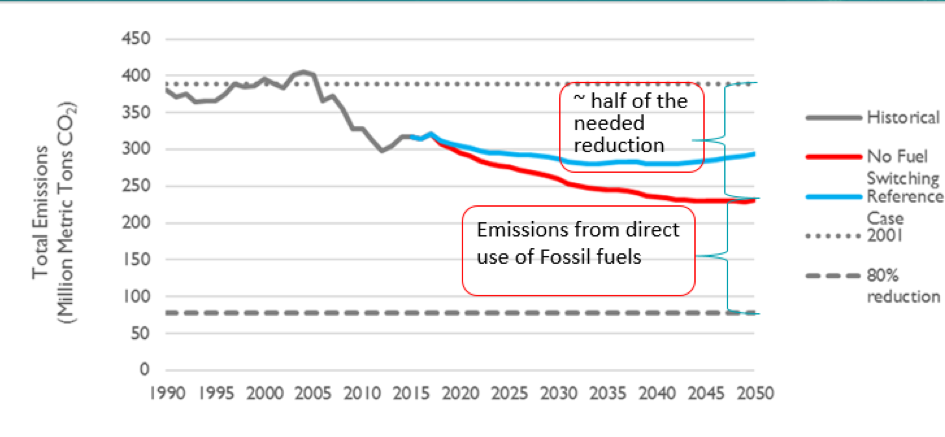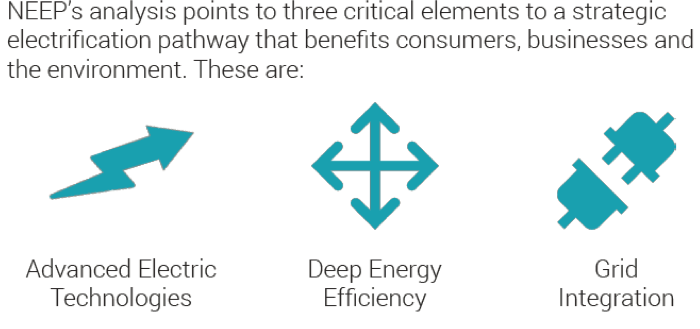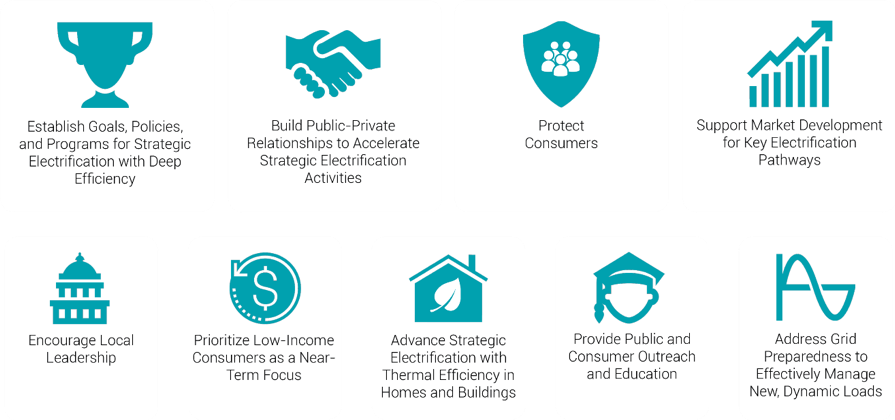By David Lis | Tue, June 5, 18
On May 17, NEEP held a public webinar to present our recently published Action Plan to Accelerate Strategic Electrification in the Northeast. While we might expect everyone to drop what they were doing to attend our webinar, we understand that the world is a busy place. In case you were one of those folks who are interested in this topic but schedules haven’t allowed either a review of the action plan or “attendance” at the webinar presentation, here are few important takeaways for regional stakeholders from NEEP’s perspective.
Takeaway #1: Thanks to our partners at Synapse Energy Economics and Meister Consulting Group for their analytic assessment of decarbonization pathways in the region, it is clear that decarbonizing several key end uses that today rely on the direct use of fossil fuels is absolutely necessary to achieve deep levels of decarbonization in our economy
In the projection below, the red line reflects increased energy efficiency and a near 100 percent renewably sourced electric grid, which gets us about halfway towards meeting 80 percent GHG reductions by 2050, a goal that has been nearly universally adopted by states across the region.

Electrification of several of these fossil-fuel driven end uses provides a path for the other half of our goal. NEEP is not alone in this assessment. Several recent deep decarbonization studies also include electrification as a key element on deep long-term reductions of GHGs in our economy. Among them are E3’s Pathways to Deep decarbonization in the United States, Acadia Center’s Energy Vision, and NRDC’s America’s Clean Energy Frontier: The Pathway to a Safer Climate Future.
Takeaway #2: A relatively small group of technologies make up the lion’s share of electrification opportunities in the Northeast
Light duty vehicles (aka cars) and space/water heating make up roughly 74 percent of the direct use of fossil fuels in the region. Transitioning these end uses from systems that directly use fossil fuels to electric alternatives provides the core technology pathways for electrification. Examples of electric alternatives include electric vehicles and heat pumps (both air and ground source for both space and water heating application). Further analysis conducted as part of the assessment stage suggests that heavy penetrations of these technologies will shift seasonal electric use from summer dominant to winter dominant. Impacts on daily peak loads was not analyzed but the possibility of far greater capacity needs are a legitimate concern.
One key variable that will significantly determine the future needs for energy and capacity on the grid is the region’s thermal load, or amount of heat needed to sufficiently condition the homes and buildings. How effectively we reduce thermal loads in homes and businesses will be a significant determinant of the scale of future electricity needs under a strategic electrification scenario. To minimize energy and load growth to the grid and to protect consumers from the impacts of significant growth, it is essential to match strategic electrification of homes and buildings with thermal efficiency improvements.
Flexibility of energy flow by electrification technologies offers a tremendous demand management benefit to the electric grid. In the near term, this flexibility can assist in “filling in the valleys” and “shaving the peaks” of our current load shapes. In the future, peak electric demand is expected to shift to winter and we will need similar flexibility in effectively managing daily load shapes on the grid to prevent costly peaks. EVs can charge when demand is low and discharge when demand is high. Variable capacity heat pumps offer the ability to ramp usage down at times of high demand. Pairing with energy storage and highly-thermal efficient homes and buildings only broadens their “flexibility”. When considering the long term impacts on the electric grid from this transition, thermal efficiency and grid integration are necessary compliments.

Takeaway #3: 2050 is 32 years away
In college, I minored in math so I hope that calculation is right. When you consider the scale of transition that we modeled as part of our assessment, you quickly realize that there is tremendous urgency to beginning our shift to electrification technologies, thermal efficiency and grid integration.
Our “plausibly optimistic” scenario that achieves slightly less than the 80 percent GHG reduction assumes very aggressive adoption rates for a number of the important technologies. For example, our scenario requires that the market share for heat pumps in homes that utilize delivered fuels (oil and propane) for space heating would have to be 89 percent in 2035. And 68 percent sales share for homes heating with natural gas. Based on rough lifetimes for existing oil and gas heating systems (15-20 years), the market has one, possibly two, opportunities to transition these customers to heat pumps over the next 17 years. We have a lot of work to develop this and other markets in order to ensure customers make these transitions.
Takeaway #4: Near-term action areas span policy, program and related market-forming activities
NEEP leveraged extensive stakeholder engagement to develop the series of recommended actions to accelerate strategic electrification in the Northeast that you’ll find in the report. Below is the collection of high level actions that came out of this process. The report includes several more specific actions for each of the broader areas.

I’ll highlight one in particular: Protect Consumers.
State utility regulators and consumer advocates should view strategic electrification as a mechanism to reduce electricity costs to all consumers through better utilization of the electric grid. Strategic electrification technologies have significant potential to utilize power during off-peak times as well as provide demand response capabilities. Electrification efforts should provide incentives and appropriate controls to consumers to support electrification growth and optimize grid integration.
Takeaway #5: Developing an action plan, while necessary and important for framing and identification of specific priority actions, is in itself the “easy” work. We all know the hard work lies ahead as the region embarks in implementing a broad and diverse set of actions
The key to implementation includes involvement from state/local policy makers, energy regulators, industry actors, NGOs, and others. NEEP stands ready to facilitate this regional effort and intends on convening interested stakeholders in a variety of forums to ensure leading efforts receive visibility, necessary research moves forward, stakeholders have opportunities to discuss successes and challenges, and progress is tracked.
Take a moment to review the action plan and form some of your own takeaways. We believe strategic electrification is a necessary strategy for the region to deploy to meet the challenge of deep decarbonization of our region. Working collaboratively and constructively as a region will ensure we rise to the opportunity to transform our energy system for the benefit of all.

